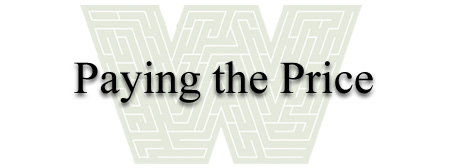
Gloomy Times and New Ideas
That maze grows out of a troubling drop in support for higher education, both in the state of Washington and across the nation. The UW is still digesting the bitter pill of a $24 million budget cut imposed last spring. But that is just part of a nationwide decline in state support.
In 1979, for every $1,000 of personal income, states set aside $11.22 to fund higher education. In 2000 states only set aside $7.94 for every $1,000 in personal income-a 30 percent drop, says the Chronicle of Higher Education.
While some blame tax cuts and spending limits for shrinking state revenues, others say a general distrust of government has hurt education funding. University of Texas President Mark Yudof thinks America's aging demographics are also part of the trend. Older citizens favor health care and public safety, he wrote in a Chronicle article, noting that higher education's share of state spending fell 14 percent between 1986 and 1996, "while Medicaid's share nearly doubled and corrections' share increase by more than 25 percent."
Whatever the causes, taxpayer support as a percentage of personal income continues to drop. One cynical analyst has charted trend lines out into the future. If state higher education funding continues to decline at the current rate, the average would hit zero by 2040. The state of Washington's graph is even sharper-following the current trends, Olympia would cease funding higher education in 25 years.

"No magic silver bullet." - Associate Provost Harlan Peterson, '81.
Photo by Mary Levin
While that scenario is highly unlikely, some UW administrators think the state is coming close to default. In 1991, the UW's state funding was only $188 per student below the average of its 24 peer universities. By 2001, the UW was more than $2,600 per student behind its peers.
The immediate future looks just as gloomy. Current revenue forecasts project a billion-dollar deficit when the Legislature meets in 2003. If state funding drops, the UW may have to cut degree programs or consider layoffs.
"We're headed into a tough season. We are looking at all the financial numbers. We have no choice. We are really on the ropes regarding the educational side of our mission," Provost Huntsman warns. "Things have reached the breaking point."
The UW will push hard for more state support during the 2003 session and is looking for alumni to help. But it also needs to consider other sources of revenue to stay competitive.
"Our faculty is used to competition-persuading someone to support their work and then delivering on it," Huntsman explains, citing the fierce competition for research funding. One sign of success: the UW is the top public university in terms of federal research awards. The UW also competes with many worthy non-profits for private gifts and grants, and there, too, it is remarkably successful. In 1999-2000 it ranked among the top five public universities in private support.
To keep the UW healthy, that energy must infuse the entire university. "A chronic shortage of resources threatens our health and our quality. We have no choice but to look for new resources-to rebalance our books. But we must not allow that rebalancing to threaten our essence as a public research university. Indeed, it is precisely our public obligations that drive our search for more resources, including more private resources," McCormick explains.
Tuition
Of the many paths out of the funding maze, the one that has gotten the most attention is tuition. The administration and the regents want the authority to set tuition, as trustees do at private and many public universities such as Michigan. They also want to abandon the "one-price-fits-all" model. If the rate for a high demand degree-an M.B.A. or a law degree-is way below the market, it should rise to market levels.
- Page 3: Is College Pretty Cheap?
- Page 4: A Quiet Corner of the University
- Page 5: Looking to the Future
- Sidebar: Ups & Downs: Futures in UW Funding
- Return to September 2002 Table of Contents